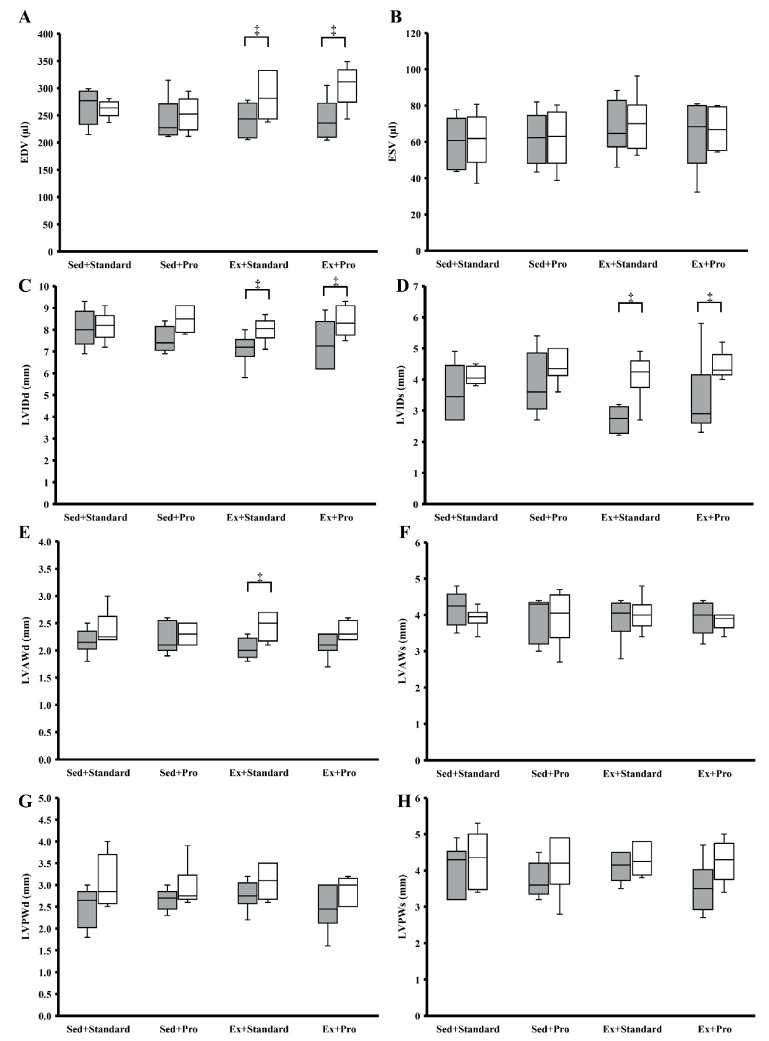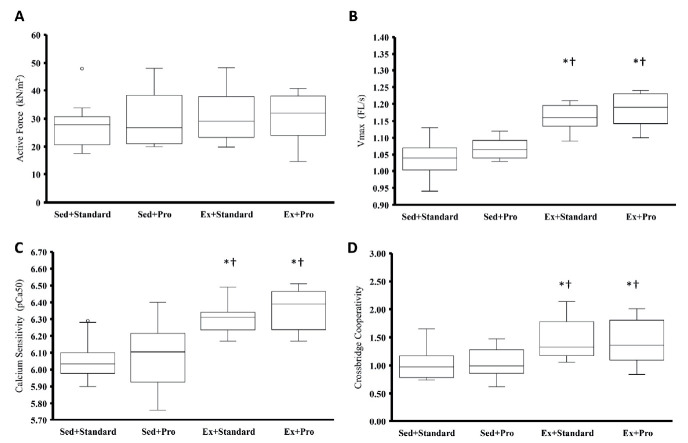A high-whey-protein diet does not enhance mechanical and structural remodeling of cardiac muscle in response to aerobic exercise in rats.
引用次数: 0
Abstract
[Purpose] Aerobic exercise training results in distinct structural and mechanical myocardial adaptations. In skeletal muscle, whey protein supplementation is effective in enhancing muscle adaptation following resistance exercise. However, it is unclear whether cardiac adaptation to aerobic exercise can be enhanced by systematic protein supplementation. [Methods] Twelve-week-old rats were assigned to 12 weeks of either sedentary or aerobic exercise with either a standard (Sed+Standard, Ex+Standard) or high-protein (Sed+Pro, Ex+Pro) diet. Echocardiography was used to measure cardiac structural remodeling and performance. Skinned cardiac fiber bundles were used to determine the active and passive stress properties, maximum shortening velocity, and calcium sensitivity. [Results] Aerobic training was characterized structurally by increases in ventricle volume (Ex+Standard, 19%; Ex+Pro, 29%) and myocardial thickness (Ex+Standard, 26%; Ex+-Pro, 12%) compared to that of baseline. Skinned trabecula r fiber bundles also had a greater unloaded shortening velocity (Sed+Standard, 1.04±0.05; Sed+Pro, 1.07±0.03; Ex-+Standard, 1.16±0.04; Ex+Pro, 1.18±0.05 FL/s) and calcium sensitivity (pCa50: Sed+Standard, 6.04±0.17; Sed+Pro, 6.08±0.19; Ex+Standard, 6.30±0.09; Ex+Pro, 6.36±0.12) in trained hearts compared to that of hearts from sedentary animals. However, the addition of a high-protein diet did not provide additional benefits to either the structural or mechanical adaptations of the myocardium. [Conclusion] Therefore, it seems that a high-whey-protein diet does not significantly enhance adaptations of the heart to aerobic exercise in comparison to that of a standard diet.



高乳清蛋白饮食不能增强大鼠有氧运动后心肌的机械和结构重塑。
目的:有氧运动训练可导致不同的心肌结构和机械适应性。在骨骼肌中,补充乳清蛋白对增强阻力运动后的肌肉适应是有效的。然而,目前尚不清楚心脏对有氧运动的适应性是否可以通过系统补充蛋白质来增强。方法:12周龄的大鼠被分配到12周的久坐或有氧运动,其中标准饮食(Sed+ standard, Ex+ standard)或高蛋白饮食(Sed+Pro, Ex+Pro)。超声心动图测量心脏结构重构和功能。剥皮心脏纤维束用于测定主动和被动应力特性、最大缩短速度和钙敏感性。结果:有氧训练的结构特征是心室容积增加(Ex+Standard, 19%;Ex+Pro, 29%)和心肌厚度(Ex+Standard, 26%;Ex+- Pro, 12%)。剥皮后的小梁纤维束也有较大的空载缩短速度(Sed+Standard, 1.04±0.05;Sed +专业,1.07±0.03;Ex- +标准,1.16±0.04;Ex+Pro, 1.18±0.05 FL/s)和钙敏感性(pCa50: Sed+Standard, 6.04±0.17;Sed +专业,6.08±0.19;+交货标准,6.30±0.09;与久坐动物相比,训练动物心脏的Ex+Pro值为6.36±0.12)。然而,添加高蛋白饮食并没有为心肌的结构或机械适应性提供额外的好处。结论:因此,与标准饮食相比,高乳清蛋白饮食似乎并没有显著增强心脏对有氧运动的适应性。
本文章由计算机程序翻译,如有差异,请以英文原文为准。
求助全文
约1分钟内获得全文
求助全文

 求助内容:
求助内容: 应助结果提醒方式:
应助结果提醒方式:


